The Sinking of RMS Atlantic
The 3,707 ton, four-masted steam ship RMS Atlantic sank on April 1, 1873 after hitting rocks off Nova Scotia, Canada. Over 560 lives were lost.
It was the worst disaster in maritime history at the time, and White star Line’s second worst ever disaster, the other being the loss of the Titanic.
Atlantic left Liverpool under the command of Captain James A Williams on March 13, 1873. It was her 19th voyage. From Liverpool, Atlantic sailed to Queenstown, arriving the next day, and upon leaving Queenstown, had abroad around 952 passengers and crew. The first few days of the voyage seem to have been uneventful – but the Captain later stated that they had endured heavy south-west and westerly gales, causing the ship to slow down.
On March 31, with an engineer’s report stating that only 127 tons of coal remained aboard the ship, there was a fear onboard that the ship might not have enough coal to reach New York. So, especially considering unfavorable weather conditions, it was decided to head the ship for Halifax, Canada, to load more coal.
At around 12am the Captain left the bridge to go to bed, and ordered that his steward should call him at 2.40am and that the deck officers should call him at 3am, or sooner if needed. Left in charge of the bridge were Atlantic’s second and fourth officers. Unknown to the crew, the ship, traveling at around 12 knots, was considerably off course to the west of where she should have been.
Despite the captain’s order to call him, his steward is said to have been told not to do so by the fourth officer, and it appears that, at 3am, the captain was not woken up.
At approximately 3.15am Atlantic smashed into a rock off Marr's Head, Nova Scotia. The passengers and crew started making their way up on to deck – but the port side lifeboats were washed away by the sea, and soon after the ship keeled to port – causing the starboard side boats to be useless. This is believed to have helped cause the death of many people still below deck.
It is said that Third Officer Brady, Quartermaster Owens and Quartermaster Speakman managed to tie a line to a rock – allowing those onboard to climb to safety; a long and perilous journey, which many drowned while trying to attempt. With the sea roaring around them and aboard the ship, those on the deck were also ordered to climb up the ships rigging or to get to a safe part of the deck.
After Third Officer Brady managed to summon help on shore, boats come from the shore to rescue the survivors. Around 562 of the around 952 people aboard died in the disaster – including all the women and children – except for one boy.
Many of the victims were buried on the shore near to the wreck site. 277 were buried in a mass grave – following a burial service led by the Reverend William Ancient – who had been involved in the rescue operation.
Located on the site is a stone memorial with the following inscription: “Near this spot was wrecked the S.S. Atlantic. April 1st 1873. When 563 persons perished. Of whom 277 were interred in this churchyard. This monument is erected as a sacred memorial by a few sympathetic friends.”
Many blame the Captain for the loss, and his account is available here.

The opinions expressed herein are the author's and not necessarily those of The Maritime Executive.
